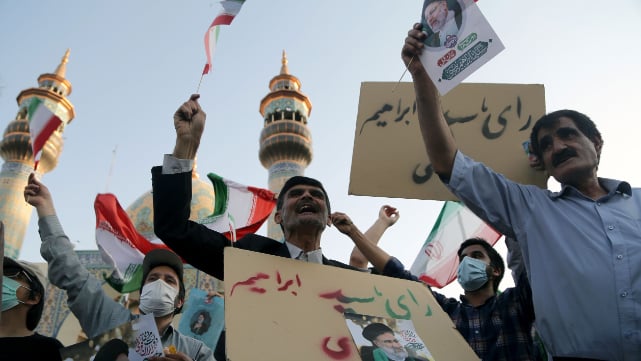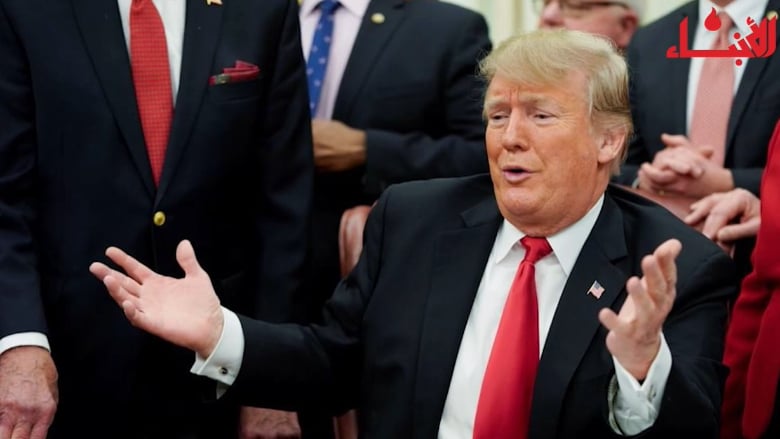By Robin Wright
Two years after a popular uprising ended two millennia of dynastic rule in Iran, the revolutionary leader Ayatollah Ruhollah Khomeini scolded the country’s squabbling politicians for “biting one another like scorpions.” Four decades later, on the eve of a Presidential election, on Friday, Iranian politics are no less contentious. At the first of three campaign debates, the former Revolutionary Guard commander Mohsen Rezaei vowed that his first act, if elected, would be to charge the leading centrist candidate, Abdolnaser Hemmati, who was seated a few feet away, with betraying the revolution. “If I become President, I will ban Hemmati and a number of other officials of the Rouhani government from leaving the country, and I will prove in court which treacherous roles they played,” he said, during a three-hour televised debate with six other candidates. Rezaei, who is making his fourth run for President, has been popularly mocked as “General Botox,” owing to the recent transformation of his face. The atmosphere was so fraught that Hemmati, a former Central Bank chief who holds a black belt in karate, made an appeal to a third candidate, the judiciary chief Ebrahim Raisi. “Mr. Raisi, can you give me assurances that no legal action will be taken against me after this event?” It was hard to tell whether Hemmati was joking or serious—or both.
The election marks the political end for President Hassan Rouhani, a centrist who won two landslide elections in 2013 and 2017, and who can’t run again because of term limits. It may also mark the end, for the foreseeable future, of a reform movement that had struggled to ease rigid restrictions at home and open Iran to the world. Rouhani had dared to run on a platform of engaging with the United States. During his first term, his team negotiated a nuclear deal with the world’s six major powers. But, during his second term, President Trump’s decision to abandon the deal—and impose more than a thousand new sanctions on Iran—doomed Rouhani and his political ilk. His popularity plummeted. Last year, hard-liners swept parliamentary elections, albeit with the lowest turnout since the 1979 revolution.
Last month, almost six hundred Iranians, including forty women, registered to run for President. Only seven were approved by the conservative, twelve-man Guardian Council; even regime loyalists were shocked. It rejected a former President, a current Vice-President, a long-serving former speaker of parliament, and the current mayor of Tehran. Five of the seven candidates approved were hard-liners deeply hostile to the West. “Goodbye reforms?” headlined one Tehran newspaper.
Raisi—the judiciary chief who came in second in the 2017 election, and who has led in polls of likely voters for this election—was sanctioned by the U.S. Treasury Department in 2019. It cited his involvement in the so-called Death Commission, which ordered extrajudicial executions of thousands of political prisoners in 1988, and his senior positions, since then, in a judicial system that executes minors. “Raisi is a pillar of a system that jails, tortures, and kills people for daring to criticize state policies,” Hadi Ghaemi, the executive director of the Center for Human Rights in Iran, said before the first Presidential debate. “Instead of running for president, he should be tried.” Last year, the U.S. also sanctioned Rezaei, noting his suspected involvement in a 1994 terrorist attack on a Jewish community center in Argentina that killed eighty-five people; Interpol still has an active warrant out for his arrest. “I am proud to be sanctioned by America,” Rezaei replied.
Hemmati, a centrist backed by many reformists, could pull off an upset if the turnout is high, Iranian and foreign analysts told me. He was gaining in the final week of the campaign. All three Presidents since 1997 have been dark horses who beat the candidates expected to win. To energize moderate voters, Hemmati announced on Wednesday that he would keep the current foreign minister, Mohammad Javad Zarif, who led the negotiations in the 2015 Iran nuclear deal, in his post or make him a Vice-President. In another boost for Hemmati, the only other reformist candidate, Mohsen Mehralizadeh, withdrew from the race on Wednesday. Yet, over the past two years, the public mood has soured on the country’s élite, analysts say. Apathy runs deep, polls show. “There’s confusion about how to deal with the massive candidate suppression,” Hadi Semati, a former professor at Tehran University, told me. “People are exhausted, but they haven’t given up completely. There’s a sense of bewilderment about whether to vote or how to vote.” The campaign is also only three weeks long—one of the shortest in the world.
Friday’s vote is about far more than the Presidency. The timing intersects with three pivots that could shape Iranian politics for decades. The first is the succession to the Supreme Leader, Ayatollah Ali Khamenei, who is now eighty-two; he has been Iran’s ultimate power for more than three decades. He had been President before he became Supreme Leader, the single precedent for a transfer of power. Iranians know that they may be voting for a man—and, in the case of Raisi, the only cleric—who could be Khamenei’s successor, and in power for longer than four or eight years.
The second driver is a generational shift. Forty-two years after the Revolution, the majority of the early revolutionaries are senior citizens—or dead. The majority of Iran’s eighty-five million people (and voters) were born after 1979. For decades, Iranian politics have been divided among hard-line and reformist factions; each had its own internal divisions. (One of my favorite Iranian jokes is “Wherever there are five Iranians, there are six parties.”) Hard-line factions could usually count on up to a quarter of voters; centrists and reformists usually rallied roughly as much. The middle forty to fifty per cent decided the outcome of elections.
But the next generation of Iranians is more diverse and not so neatly categorized. The new guard is also eager to push out the old guard, Semati said. Younger conservatives are often more hard-line and more ideological than their elders, partly because they didn’t experience the hardships that came in the wake of the Revolution and the eight-year war with Iraq, which forced pragmatic compromises. Many young centrists and reformists have been depoliticized. The movement has failed to produce, politically or economically, and it now lacks coherence and a post-Rouhani leader. “Mobilizing them is harder than ever,” Semati said.
The third driver is the increasing dysfunction of Iran’s hybrid political system. The Islamic Republic uniquely blends the Western principles of a republic (borrowing heavily from the Napoleonic Code) with Islamic law. Almost every dispute over domestic and foreign policy has, at its core, reflected the internal tensions over whether revolutionary Iran is first and foremost a republic, where man’s law and the public’s electoral choices are supreme, or whether it is an Islamic state, where God’s law and the clergy have the final word. Since 1989, when a constitutional amendment introduced an executive Presidency, the President—whether hard-line or reformist—has been at odds with the Supreme Leader on how much control the elected government really has. Two former Presidential candidates—the former Prime Minister Mir-Hossein Mousavi and the former speaker of parliament Mehdi Karroubi—are still under house arrest, a decade after supporting the 2009 Green Movement’s mass protests against alleged election fraud. This year, the list of approved candidates reflects a clear attempt by conservatives to direct the future of the country at an epic juncture in this debate.
Iran is also notoriously corrupt. It was bad under the monarchy; it is hideous under the theocracy. In 2019, Rouhani’s brother was sentenced to five years for corruption and bribery. Raisi initially resonated with voters because he has championed—at least rhetorically—a crackdown on corruption ever since the Supreme Leader appointed him to be Iran’s chief justice, in 2019.
Given Iran’s myriad challenges, Khamenei may be trying to influence more than the succession, Ali Vaez, the Iran project director for the International Crisis Group, told me. The Supreme Leader is willing to risk the legitimacy of the election—which would be reflected in a large turnout—in order to consolidate monolithic control by hard-line politicians loyal to rigid revolutionary principles. “He is doing this because he wants a pliant President and a pliant parliament to bring reforms that insure a pliant system that will minimize resistance to transformational changes and protect his legacy,” Vaez said. Khamenei hopes to orchestrate a political overhaul that could effectively remove the republican aspects from Iran’s political system. His goals may include weakening, potentially even eliminating, the Presidency by returning to a parliamentary system, which was used during the first post-Revolution decade. The President was then only a titular position unable to challenge the Supreme Leader. “After three decades as Supreme Leader, Khamenei understands that the system is dysfunctional,” Vaez said. “The Supreme Leader cares more about outcome than turnout because he is laying the groundwork for structural changes in the Islamic Republic.”
Barring a surprise upset by Hemmati, or a runoff election if none of the candidates gets over half the votes, Iranian politics are moving to a single-party system dominated by conservatives, Semati said. In a bid to boost Raisi, the hard-line lawmaker Alireza Zakani and Saeed Jalili, a member of the Supreme National Security Council, withdrew from the race on Wednesday. More than two hundred members of parliament also issued an appeal calling for other hard-line candidates to pull out, too. Yet creating a monolithic political bloc that endures indefinitely will be as difficult as it was in the past. The early revolutionaries splintered into dozens of factions, forcing Khomeini to dissolve the single Islamic Republican Party, in 1987. “Iran can’t be run by a single party,” Semati said. “They would love to do it, but Iranian political culture is more developed than anywhere else in the region. It’s not easy for any party to dominate.” The scorpion analogy still holds.





